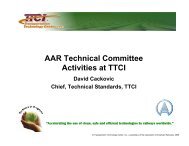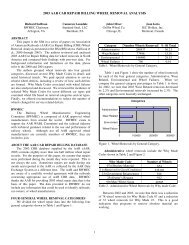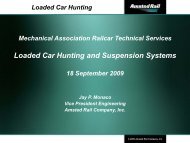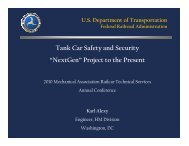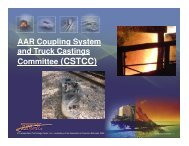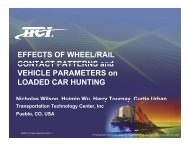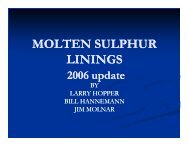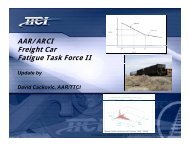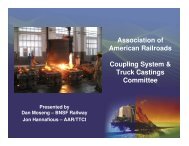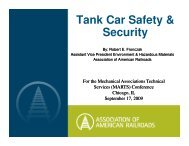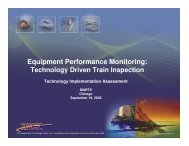Technology Driven Train Inspection - Marts-rail.org
Technology Driven Train Inspection - Marts-rail.org
Technology Driven Train Inspection - Marts-rail.org
Create successful ePaper yourself
Turn your PDF publications into a flip-book with our unique Google optimized e-Paper software.
<strong>Technology</strong> <strong>Driven</strong> <strong>Train</strong> <strong>Inspection</strong><br />
Presented to<br />
Mechanical Association<br />
Railcar Technical Services<br />
TM<br />
Chicago<br />
Jim Lundgren<br />
Sep 21, 2005<br />
MARTS 2005 / Lundgren - 1 © Transportation <strong>Technology</strong> Center, Inc., a subsidiary of the Association of American Railroads, 2005
Outline<br />
MARTS 2005 / Lundgren - 2<br />
◆ Introduction<br />
◆ Background<br />
◆ <strong>Technology</strong> <strong>Driven</strong> <strong>Train</strong> <strong>Inspection</strong> (TDTI)<br />
◆ Wheel Condition Monitoring<br />
◆ FactIS TM<br />
◆ Acoustic Bearing Defect Detection<br />
◆ Wayside Truck Performance Detection<br />
◆ InteRRIS TM<br />
◆ Wayside Cracked Wheel Detection<br />
◆ Wayside Cracked Axle Detection<br />
◆ The Future<br />
TM<br />
TM<br />
© TTCI/AAR, 2005
Introduction<br />
◆ Railroad fleets require inspection, maintenance, &<br />
repair<br />
◆ Ensuring rolling stock receives maintenance prior<br />
to service degradation or interruption is challenging<br />
task<br />
◆ Railroads incorporate new techniques and<br />
technologies for more complete, effective, and<br />
efficient inspections<br />
◆ Emerging technology applications have recently<br />
been adapted to <strong>rail</strong>way use in automating<br />
inspection of moving <strong>rail</strong> cars from wayside or<br />
trackside locations<br />
TM<br />
MARTS 2005 / Lundgren - 3<br />
© TTCI/AAR, 2005
Background<br />
◆ Systems Used For Many Years<br />
● Hot Bearing Detectors (HBD)<br />
● Wheel Impact Load Detectors (WILD)<br />
● Dragging Equipment Detectors (DED)<br />
● Hot Wheel Detector (HWD)<br />
● Cold Wheel Detector (CWD)<br />
◆ Recently Deployed Technologies – last 6-8 yrs<br />
● Truck Performance Detector (TPD)<br />
● Acoustic Bearing Detector (ABD)<br />
● Truck Hunting Detector (THD)<br />
MARTS 2005 / Lundgren - 4<br />
● High Speed Video Imaging (HSVI)<br />
TM<br />
© TTCI/AAR, 2005
Background (continued)<br />
Several Technologies On Near Horizon<br />
◆ Newer Wheel Profile Monitoring (WPM) systems<br />
◆ Newer Truck Hunting Detection (THD) systems<br />
◆ Laser Ultrasonic based wheel and axle<br />
inspection systems<br />
● Cracked Wheel Detector (CWD)<br />
● Cracked Axle Detector (CAD)<br />
TM<br />
MARTS 2005 / Lundgren - 5<br />
© TTCI/AAR, 2005
Purpose of TDTI<br />
Improve productivity, safety, & customer satisfaction<br />
◆ Railways have progressively moved away from emergency &<br />
reactive repairs to planned & scheduled component replacement<br />
◆ Increasingly look to technology to assist in managing their rolling<br />
stock assets (cost reduction, damage prevention, & equipment<br />
use)<br />
◆ Last 25 yrs, US <strong>rail</strong>ways doubled revenue freight ton-miles &<br />
reduced freight car fleet by 23 % and employment by 58 %<br />
◆ Improved inspection systems have played an significant role in<br />
productivity improvements<br />
◆ Customer service & satisfaction a key driver and an essential<br />
benefit from using <strong>Technology</strong> <strong>Driven</strong> <strong>Train</strong> <strong>Inspection</strong> (TDTI)<br />
TM<br />
MARTS 2005 / Lundgren - 6<br />
© TTCI/AAR, 2005
◆ Thermal<br />
TDTI – Deployed Technologies<br />
● Hot Bearing Detection<br />
● Hot Wheel Detection<br />
◆ Strain Gauge-based<br />
● Wheel Impact<br />
● Overload & Imbalanced<br />
Load<br />
● Truck Performance<br />
● Hunting<br />
Spiral<br />
Cribs in Tangent<br />
Spiral<br />
TM<br />
MARTS 2005 / Lundgren - 7<br />
© TTCI/AAR, 2005
TDTI – Newer Technologies<br />
◆ Image-Based<br />
● Wheel Profile<br />
● Missing, Worn or Damaged<br />
Components<br />
● Hunting<br />
◆ Sensor-based Truck Hunting<br />
◆ Acoustic<br />
● Acoustic Bearing Detection<br />
● Leaking Air Sensors<br />
◆ Ultrasonic<br />
● Cracked Wheel<br />
● Cracked Axle<br />
TM<br />
MARTS 2005 / Lundgren - 8<br />
© TTCI/AAR, 2005
Economic Benefits of TDTI<br />
◆ Investments in TDTI must compete for limited capital<br />
funds<br />
◆ TTCI has performed a number of extensive cost/benefit<br />
studies for the North American <strong>rail</strong>road industry<br />
◆ Usually, ROI calculation based on benefit streams from<br />
safety, improved asset utilization, cost avoidance, and<br />
improved customer satisfaction<br />
◆ Example - WILD cost/benefit study<br />
● Considered trade-off between early removal of wheel<br />
sets (loss of remaining life) and reduced damage to<br />
track<br />
● Economic benefit of removing high impact wheels<br />
using WILD technology in the U.S. <strong>rail</strong>way industry is<br />
in excess of $40 million per year<br />
TM<br />
MARTS 2005 / Lundgren - 9<br />
© TTCI/AAR, 2005
TDTI Must Address <strong>Inspection</strong> Requirements<br />
◆ In US, all train inspections are specified in the Code of<br />
Federal Regulations (CFR) Title 49:<br />
● Freight Car Safety Standards (Part 215)<br />
● Railroad Safety Appliance Standards (Part 231)<br />
● Brake Systems Safety Standards (Part 232)<br />
◆ Railroads abide by CFR49 rules by conducting pre-<br />
departure (outbound) inspections<br />
◆<br />
For efficiency many <strong>rail</strong>roads perform post arrival or<br />
inbound inspections<br />
●<br />
●<br />
●<br />
Allows a yard or switching facility to locate and tag defective (Bad<br />
Order) cars prior to making up or blocking new trains<br />
Bad ordered cars are switched directly to a repair track where repairs<br />
and subsequent inspections are made to remove and document the<br />
failed components<br />
Practice prevents defective cars from being placed in a new train and<br />
then having to be switched out when the defects were discovered<br />
TM<br />
MARTS 2005 / Lundgren - 10<br />
© TTCI/AAR, 2005
TDTI Targets Of Opportunity<br />
◆ HSVI to determine wheel & brake system conditions<br />
appear to provide most immediate benefit<br />
◆ Wheel Info: flange height & thickness, rim thickness, and wheel<br />
hollow wear<br />
◆ Brake System Info: brake shoe thickness, worn or missing brake<br />
MARTS 2005 / Lundgren - 11<br />
heads, missing brake shoe keys, brake beam & slack adjuster<br />
conditions, hand brake position (on or off), and brake application &<br />
release verification<br />
◆ Others measurements of interest:<br />
●<br />
●<br />
●<br />
●<br />
●<br />
●<br />
Coupler and draft gear condition<br />
Bearing adapter position / condition & spring nest condition<br />
Sliding wheel detection, end cap bolt presence, & locking plate<br />
condition<br />
Safety appliance position and condition<br />
Grease leakage from cartridge journal bearings<br />
Non-destructive evaluation of wheels and axles<br />
TM<br />
© TTCI/AAR, 2005
Desired TDTI System Attributes<br />
◆ Easy installation<br />
● No operational disruption<br />
● No hindrance to maintenance operations<br />
◆ Low maintenance requirements<br />
◆ Long service life / durability<br />
◆ Accurate, repeatable data<br />
◆ Useful inspections for actionable<br />
maintenance<br />
◆ Solid return on investment<br />
TM<br />
MARTS 2005 / Lundgren - 12<br />
© TTCI/AAR, 2005
TDTI - Wheel Condition Monitoring<br />
• Systems based on HSVI & laser<br />
technologies<br />
• Currently available wheel profile<br />
measurement systems<br />
• AEAT/Alstom Treadview TM System<br />
• BeenaVision WP System<br />
• Hegenscheidt ARGUS<br />
• Imagemap WheelSpec TM System<br />
• KLD WheelScan<br />
• TTCI FactIS TM<br />
TM<br />
MARTS 2005 / Lundgren - 13<br />
© TTCI/AAR, 2005
AEAT/Alstom TreadView TM System<br />
• System installed at Longsight <strong>Train</strong>care<br />
Depot in Manchester, UK<br />
• Wheel Profile Measurement Parameters<br />
• Flange Thickness Rim Thickness<br />
• Flange Height<br />
TM<br />
MARTS 2005 / Lundgren - 14<br />
© TTCI/AAR, 2005
BeenaVision Wheel Profile System<br />
◆ System installed at TTC’s FAST track & evaluated in<br />
late 03 & early 04 – results looked promising<br />
◆ Wheel Profile Measurement Parameters<br />
• Flange Thickness Rim Thickness<br />
• Flange Height Tread Hollow<br />
TM<br />
MARTS 2005 / Lundgren - 15<br />
© TTCI/AAR, 2005
Hegenscheidt - ARGUS<br />
◆<br />
◆<br />
◆<br />
◆<br />
Diagnostic system for inspecting<br />
wheelsets on a moving train<br />
Monitors wheelset tolerances and<br />
operating deviations<br />
Improves safety, travelling comfort<br />
& operational reliability.<br />
Automatic, precise and fast<br />
measuring operation<br />
●<br />
●<br />
Provides wear forecast<br />
Increases vehicle availability by<br />
monitoring wheelset wear<br />
TM<br />
MARTS 2005 / Lundgren - 16<br />
© TTCI/AAR, 2005
ImageMap WheelSpec System<br />
◆<br />
◆<br />
◆<br />
Hi-Speed Wheel Profile Systems for Mainline Measurement of<br />
Wheel Profiles and Wheel Gauge at Speeds up to 100 km/h<br />
Lo-Speed Wheel Profile Systems for Yard and Depot use. High<br />
Accuracy Measurement for Equivalent Conicity Calculations<br />
Measurement of Out-of round and Wheel Flats<br />
Database Systems for Wheel Fleet Data Management<br />
TM<br />
MARTS 2005 / Lundgren - 17<br />
© TTCI/AAR, 2005
KLD Labs - WheelScan System<br />
◆ Uses a combination of lasers and video cameras to profile<br />
and measure the wheel<br />
◆ Acquires video images of the wheel profile and performs<br />
dimensional measurements and identification in real-time<br />
◆ Information compared to <strong>rail</strong>way's wheel criteria for<br />
exception reporting. Easily integrated with other wayside<br />
instrumentation for comprehensive wheel analysis<br />
TM<br />
MARTS 2005 / Lundgren - 18<br />
© TTCI/AAR, 2005
Teknis Wheel Condition Monitor (WCM)<br />
◆<br />
◆<br />
◆<br />
◆<br />
Provides in-motion weighing, load pattern analysis, wheel defect<br />
classification, automatic vehicle identification, hot-box, bogie<br />
geometry, wheel profiles and lateral vehicle tracking.<br />
Hybrid system of accelerometers and strain gauges to provide<br />
both static and dynamic data<br />
Linked to user-defined alarms and automatic report generation<br />
Evaluates total damage potential of a wheel<br />
TM<br />
MARTS 2005 / Lundgren - 19<br />
© TTCI/AAR, 2005
Wheel Impact Load Detectors<br />
1.5 x 5 in. Shell, 106 k Electronic Equipment<br />
TM<br />
MARTS 2005 / Lundgren - 20<br />
© TTCI/AAR, 2005
FactIS TM Product Vision<br />
◆ Implement an inspection and information system that provides<br />
major efficiencies in allowing <strong>rail</strong>roads to achieve compliance<br />
with government safety regulations and industry maintenance<br />
standards<br />
◆ The vision advocates a long-term approach of developing<br />
sufficient numbers of inspection modules to replace all<br />
inspections currently conducted by yard inspectors<br />
●<br />
A system of integrated sensors that can duplicate inspections<br />
required under CFR49 Parts 215, 231, and 232<br />
●<br />
System must provide data that can be used in lieu of the manual<br />
inspection requirements<br />
TM<br />
MARTS 2005 / Lundgren - 21<br />
© TTCI/AAR, 2005
CN FactIS TM During Checkout<br />
TM<br />
MARTS 2005 / Lundgren - 22<br />
© TTCI/AAR, 2005
FactIS TM - Wheel Profile Module<br />
◆ Cameras and<br />
flashlamps mounted<br />
between <strong>rail</strong>s inspect<br />
wheels as they pass<br />
◆ Triggered by wheel<br />
sensors clamped to<br />
field side of <strong>rail</strong><br />
TM<br />
MARTS 2005 / Lundgren - 23<br />
© TTCI/AAR, 2005
Strobe Lights & Trigger Boxes<br />
Synchronized for video frame capture<br />
clarity<br />
Clarity independent of site lighting<br />
conditions<br />
TM<br />
MARTS 2005 / Lundgren - 24<br />
© TTCI/AAR, 2005
Computers<br />
& Support<br />
Electronics For<br />
Wheel Profile &<br />
Brake Shoe<br />
Modules<br />
TM<br />
MARTS 2005 / Lundgren - 25<br />
© TTCI/AAR, 2005
Wheel Flange Video Capture at 60 mph<br />
Capabilities:<br />
•Flange height<br />
•Flange thickness<br />
•Flange angle<br />
•Rim thickness<br />
•Tread hollow<br />
•Back-to-back<br />
•Differential diameter<br />
TM<br />
MARTS 2005 / Lundgren - 26<br />
© TTCI/AAR, 2005
WPM Data Repeatability<br />
CTRN 601054 L3 Tread Hollow<br />
CTRN 601054 L3 Rim Thickness<br />
Thickness in mm<br />
0.80<br />
0.60<br />
0.40<br />
0.20<br />
0.00<br />
-0.20<br />
-0.40<br />
-0.60<br />
-0.80<br />
1 2 3 4 5 6 7 8 9 10<br />
Series1<br />
Series2<br />
Series3<br />
Series4<br />
Thickness in mm<br />
44.50<br />
44.00<br />
43.50<br />
43.00<br />
42.50<br />
42.00<br />
41.50<br />
41.00<br />
40.50<br />
40.00<br />
1 2 3 4 5 6 7 8 9 10<br />
FactIS<br />
Target<br />
UCL<br />
LCL<br />
Measurement #<br />
Measurement #<br />
CTRN 601054 L3 Flange Width<br />
CTRN 601054 L3 Flange Height<br />
37.50<br />
30.50<br />
37.00<br />
30.00<br />
Width in mm<br />
36.50<br />
36.00<br />
35.50<br />
35.00<br />
34.50<br />
34.00<br />
FactIS<br />
Target<br />
UCL<br />
LCL<br />
Height in mm<br />
29.50<br />
29.00<br />
28.50<br />
28.00<br />
27.50<br />
27.00<br />
FactIS<br />
Target<br />
UCL<br />
LCL<br />
33.50<br />
1 2 3 4 5 6 7 8 9 10<br />
Measurement #<br />
26.50<br />
1 2 3 4 5 6 7 8 9 10<br />
Measurement #<br />
TM<br />
MARTS 2005 / Lundgren - 27<br />
© TTCI/AAR, 2005
Example of Measurement Repeatability<br />
Flange Hight for Car No 1987<br />
33.0<br />
mm<br />
32.0<br />
31.0<br />
30.0<br />
29.0<br />
28.0<br />
27.0<br />
Left 1<br />
Left 2<br />
Left 3<br />
Left 4<br />
Right 1<br />
Right 2<br />
Right 3<br />
Right 4<br />
26.0<br />
1 2 3 4 5 6 7 8 9 10 11 12 13 14 15 16 17 18 19 20 21<br />
Sequential measurments<br />
TM<br />
MARTS 2005 / Lundgren - 28<br />
© TTCI/AAR, 2005
FactIS TM - Brake Shoe Module<br />
Cameras & flashlamps attached to masts in way-side<br />
track area inspect brake shoes as train passes<br />
TM<br />
MARTS 2005 / Lundgren - 29<br />
© TTCI/AAR, 2005
Brake Shoe Captures at 60 MPH<br />
• Top brake shoe thickness<br />
• Bottom shoe thickness<br />
• Loco wheel witness groove<br />
• Broken brake shoe<br />
• Missing brake shoe<br />
TM<br />
MARTS 2005 / Lundgren - 30<br />
© TTCI/AAR, 2005
BSM Data Repeatability<br />
CTRN 601054 L2 Brake Shoe Top<br />
Height in mm<br />
46.00<br />
44.00<br />
42.00<br />
40.00<br />
38.00<br />
36.00<br />
FactIS<br />
Target<br />
UCL<br />
LCL<br />
34.00<br />
1 2 3 4 5 6 7<br />
Measurement #<br />
CTRN 601054 L2 Brake Shoe Bottom<br />
Height in mm<br />
43.00<br />
42.00<br />
41.00<br />
40.00<br />
39.00<br />
38.00<br />
37.00<br />
36.00<br />
35.00<br />
1 2 3 4 5 6 7<br />
Measurement #<br />
FactIS<br />
Target<br />
UCL<br />
LCL<br />
TM<br />
MARTS 2005 / Lundgren - 31<br />
© TTCI/AAR, 2005
Bearing Adaptor Module<br />
Bearing Adaptor Info<br />
Determines bearing<br />
adapter position &<br />
condition<br />
Also examines bearing<br />
end cap & bolts<br />
TM<br />
MARTS 2005 / Lundgren - 32<br />
© TTCI/AAR, 2005
Leaning Loads Module<br />
• Leaning loads<br />
• Imbalanced loads<br />
• Differential spring<br />
height used to detect<br />
leaning / imbalanced<br />
loads<br />
•Spring condition<br />
TM<br />
MARTS 2005 / Lundgren - 33<br />
© TTCI/AAR, 2005
Thermal Scan module<br />
◆ Scans for sticking brakes and hot bearings<br />
Detects hot<br />
wheel/bearing &<br />
identifies axle of<br />
concern<br />
Displays<br />
image with –<br />
in this case a<br />
worn off brake<br />
TM<br />
MARTS 2005 / Lundgren - 34<br />
© TTCI/AAR, 2005
Truck Hunting Module<br />
◆ Paired inductive proximity sensors detect<br />
lateral position & AOA of wheelsets<br />
◆ Path through array of paired sensors<br />
determined<br />
◆ Data checked for hunting characteristics<br />
TM<br />
MARTS 2005 / Lundgren - 35<br />
© TTCI/AAR, 2005
FactIS TM Systems Status*<br />
◆ NS Installation – 30 to 35 mph system<br />
● Includes Wheel Profile Module<br />
● Installed at Eggleston, VA<br />
◆ BNSF Installation – 30 to 35 mph system<br />
● Includes Wheel Profile & Brake Shoe Modules<br />
● System assembled & checked out at TTCI in Dec<br />
● System installed at Alliance, Nebraska<br />
◆ CN Installation – 60 mph system<br />
● Includes High Speed Wheel Profile & Brake Shoe<br />
Modules<br />
● System assembled & checked out at TTCI in Dec<br />
● Installed at Stony Plain, Alberta, Canada<br />
MARTS 2005 / Lundgren - 36<br />
*Work continues on full impact, weather, & environmental<br />
hardening for severe revenue service<br />
TM<br />
© TTCI/AAR, 2005
Acoustic-Based<br />
Bearing Defect Detection<br />
◆ Roller bearing defects can have catastrophic<br />
results. The <strong>rail</strong> industry in North America<br />
has taken strong measures to both mitigate<br />
and prevent bearing failures. Yet there is a<br />
persistent number of failures that occur each<br />
year.<br />
◆ Acoustic bearing detection is designed to<br />
provide a means of monitoring roller bearings<br />
and identifying those with internal defects<br />
prior to overheating, costly train stops, and<br />
ultimately failure.<br />
TM<br />
MARTS 2005 / Lundgren - 37<br />
© TTCI/AAR, 2005
Bearing <strong>Inspection</strong>s<br />
Typical Defects<br />
TM<br />
MARTS 2005 / Lundgren - 38<br />
© TTCI/AAR, 2005
CUP<br />
SPALLS<br />
SPUN CONES<br />
SPALLED<br />
CONE<br />
Water<br />
Etch<br />
GOOD<br />
4 10 14 15 18 19 22 27<br />
TM<br />
MARTS 2005 / Lundgren - 39<br />
© TTCI/AAR, 2005
Vipac RailBAM®<br />
◆ Collects acoustic bearing fault & wheel flat data for trains at<br />
'steady' speeds of 30 to 120 kph<br />
◆ Identifies and ranks faults in underway rolling stock<br />
●<br />
●<br />
Running Surface faults - spalls, water etching, brinnelling, etc<br />
on cup and cone or rollers<br />
Looseness / Fretting faults - including inner or outer ring wear,<br />
loose or spun cones, worn seals<br />
◆ RailBAM® Trending Database provides automated<br />
downloading of multiple site fault data to a central Server<br />
PC at Customer <strong>Train</strong> Control<br />
MARTS 2005 / Lundgren - 40<br />
© TTCI/AAR, 2005<br />
TM
Trackside Acoustic Detection Systems are<br />
Used to Identify Defective Bearings<br />
◆ Expert system interprets acoustic signatures<br />
◆ Data transfer thru Internet into InteRRIS TM<br />
Typical Defects Found:<br />
◆Larger cup spalls (bar lines, etc)<br />
◆Cone spalls<br />
◆Water etch<br />
◆Early spun cones (cone turning on journal,<br />
detected because of spalls)<br />
◆Roller defects (spalls and seamed)<br />
Predictive Trends Identified<br />
from Integrated HBD System<br />
Loose cone with roller spalling,<br />
detected by large cup spall<br />
MARTS 2005 / Lundgren - 41<br />
UNPL – Upper Limit<br />
LNPL – Lower Limit<br />
TM<br />
© TTCI/AAR, 2005
Trackside Acoustic Detection System<br />
(TADS)<br />
◆ Multiple microphone trackside array<br />
◆ Ethernet linked, multi-computer high-speed<br />
data acquisition system<br />
◆ AEI integrated<br />
◆ Internet connected<br />
◆ InteRRIS compatible<br />
◆ Remote monitoring and diagnostic capability<br />
◆ Lightning protected<br />
◆ Notifications by e-mail, page, FAX, or modem<br />
connection<br />
TM<br />
MARTS 2005 / Lundgren - 42<br />
© TTCI/AAR, 2005
TADS Description<br />
Trackside Microphone Array<br />
TM<br />
MARTS 2005 / Lundgren - 43<br />
© TTCI/AAR, 2005
TADS Description<br />
Bungalow<br />
Equipment<br />
Enclosures<br />
TM<br />
MARTS 2005 / Lundgren - 44<br />
© TTCI/AAR, 2005
TADS Installation Experience<br />
◆ 13 (soon to be 36) sites on 4 continents<br />
◆ Sites cover:<br />
● Double & single track configurations<br />
● Electrified & non-electrified territory<br />
● North American northern climate to African/<br />
Australian southern climate conditions<br />
● Rural and urban locations<br />
◆ Defects detected in AAR Classes “C”, “D”, “E”, “F”,<br />
“G”, and “K” roller bearings<br />
● Spherical roller bearings<br />
◆ Over 600 bearing inspections completed to date<br />
TM<br />
MARTS 2005 / Lundgren - 45<br />
© TTCI/AAR, 2005
Representative TADS Installations<br />
MARTS 2005 / Lundgren - 46<br />
13 (soon to be 36) sites on 4 continents<br />
TM<br />
© TTCI/AAR, 2005
Database Capabilities<br />
◆ TADS data sent to single or multiple<br />
databases (e.g. customer owned and/or<br />
InteRRIS)<br />
◆ Evaluation results sent on each bearing of<br />
each train – defect present (Y or N)<br />
● 2 outputs for suspected defects<br />
▼ Defect location, severity ranking<br />
◆ Database tools available for:<br />
● Graphical display of train, car, or bearing<br />
history<br />
● Acoustic review of detected bearing<br />
defects<br />
TM<br />
MARTS 2005 / Lundgren - 47<br />
© TTCI/AAR, 2005
Wayside <strong>Inspection</strong> Devices – T/BOGI<br />
◆ Truck/Bogie Optical Geometry <strong>Inspection</strong> (T/BOGI)<br />
station is a powerful new tool enabling <strong>rail</strong>roads to<br />
reduce their operating costs by monitoring bogies for<br />
correct alignment<br />
◆ Measures the angle of attack and tracking position of<br />
individual wheelsets of a passing train in real time.<br />
TM<br />
MARTS 2005 / Lundgren - 48<br />
© TTCI/AAR, 2005
Truck Performance Detector (TPD)<br />
Primary Measurements<br />
•Lateral Wheel Load<br />
•Vertical Wheel Load<br />
•Axle Angle of Attack<br />
(AoA)<br />
•Automated<br />
Equipment<br />
Identification (AEI)<br />
TM<br />
MARTS 2005 / Lundgren - 49<br />
© TTCI/AAR, 2005
TTCI Truck Performance Detectors<br />
Identify Poorly Performing Trucks<br />
◆ Flange Climb High L/V and AoA<br />
◆ Rail Roll Over High TSLV<br />
◆ Track Panel Shift High NAL<br />
◆ Gage Spreading High Lateral<br />
◆ Warped Truck High AoA<br />
◆ Wheel Unloading Low Vertical<br />
◆ Track Damage High Vertical<br />
◆ Increase Safety<br />
◆ Reduce Fuel Costs<br />
◆ Evaluate New Components<br />
◆ Optimize/Schedule Vehicle Repair<br />
◆ Reduce Damage to Track & Equipment<br />
TM<br />
MARTS 2005 / Lundgren - 50<br />
© TTCI/AAR, 2005
High Rail Time Plot from FAST <strong>Train</strong><br />
Ideal Lube Condition<br />
Dry Lube Condition<br />
Lateral Loads from 6 kips to 14 kips<br />
Axle Angle of Attack from 7mrad to 13mrad<br />
TM<br />
MARTS 2005 / Lundgren - 51<br />
© TTCI/AAR, 2005
Tangent Lateral Forces<br />
of a Vehicle that De<strong>rail</strong>ed<br />
TM<br />
MARTS 2005 / Lundgren - 52<br />
© TTCI/AAR, 2005
®<br />
What is InteRRIS ® ?<br />
◆ Integrated Railway Remote Information<br />
Service<br />
◆ Database for automatically storing and<br />
analyzing vehicle performance data<br />
◆ TTCI began development in 1999<br />
◆ Specific notifications are sent to its<br />
customers about vehicle performance based<br />
on their unique parameters, criteria, and<br />
limits<br />
TM<br />
MARTS 2005 / Lundgren - 53<br />
© TTCI/AAR, 2005
New and Existing Detectors<br />
WILD<br />
Truck<br />
Performance<br />
Detector<br />
Wheel<br />
Profile<br />
Detector<br />
Acoustic<br />
Detector<br />
Vehicle<br />
Histories<br />
®<br />
Future<br />
Detectors<br />
Vehicle<br />
Owner/<br />
Handling Line<br />
Queries<br />
Messages to Vehicle Owner or Handling Line<br />
TM<br />
MARTS 2005 / Lundgren - 54<br />
© TTCI/AAR, 2005
TTCI Vehicle Health Monitoring Objectives<br />
◆ Develop wayside vehicle health monitoring systems<br />
● Monitor passing trains with wayside inspection systems<br />
● Measure vehicle performance characteristics that can<br />
contribute to excessive stresses<br />
● Identify specific vehicles with inspected parameters that<br />
exceed stress thresholds<br />
● Report identified vehicles to appropriate <strong>rail</strong>road<br />
maintenance <strong>org</strong>anizations<br />
◆ TTCI research focused on three wayside<br />
systems in 2004<br />
● Cracked wheel detection – SRI 6A<br />
● Cracked axle detection – eight member consortia<br />
● Automated car inspection – TTCI IR&D / partnership<br />
TM<br />
MARTS 2005 / Lundgren - 55<br />
© TTCI/AAR, 2005
Wayside Cracked Wheel Detection<br />
Chronology of Development Efforts<br />
◆ 2000: Ultrasonic NDI testing at Hollidaysburg<br />
◆ 2001: Feasibility experiment with Center for Non-<br />
Destructive Evaluation (CNDE) at Johns Hopkins<br />
University (JHU) using Laser Ultrasonic NDI<br />
technology<br />
◆ 2002: Development / conduct of a Proof of Concept<br />
(POC) demonstration at TTCI using Laser technology<br />
◆ 2003/4: Additional research at JHU and development<br />
& testing of a CWD limited prototype system at TTCI<br />
using Laser Ultrasonic technology<br />
TM<br />
MARTS 2005 / Lundgren - 56<br />
© TTCI/AAR, 2005
Wayside Wheel Crack Detection<br />
Hollidaysburg Summary<br />
In-shop Rotating Wheel<br />
Detection System<br />
• UT applicable for wheel<br />
in-shop inspections<br />
• Issues for wayside<br />
application:<br />
• System reliability<br />
• Detection of critical<br />
defects<br />
• Adequate ultrasonic<br />
coupling<br />
• System maintenance<br />
requirements<br />
• System complexity<br />
TM<br />
MARTS 2005 / Lundgren - 57<br />
© TTCI/AAR, 2005
Wayside Wheel Crack Detection<br />
Contract with CNDE at JHU<br />
Objective: Develop a wayside ultrasonic nondestructive<br />
inspection (NDI) capability for <strong>rail</strong>way wheels in motion<br />
• NDI wheel inspection capability requirements :<br />
• Inspect moving wheels on track<br />
• <strong>Inspection</strong> sensors work without contacting wheels<br />
• Components robust for RR operational environment<br />
• Rapid inspection methods to meet motion requirement<br />
• NDI capability implemented in three phases<br />
• Phase 1 – Laboratory tests to demonstrate feasibility<br />
• Phase 2 – “On-track” proof-of<br />
of-concept demonstration<br />
• Phase 3 – Operational prototype system at TTC<br />
TM<br />
MARTS 2005 / Lundgren - 58<br />
© TTCI/AAR, 2005
Axle <strong>Inspection</strong>s Using Laser Ultrasonics<br />
Crack<br />
Laser Generation Point<br />
Air–Coupled<br />
Transducers<br />
◆ Focusing laser to a line generates surface waves<br />
◆ Surface waves propagate in both directions (red lines)<br />
◆ Both transducers receive peak amplitude direct<br />
surface waves when no crack is present<br />
◆ If a crack is present<br />
● Peak amplitude direct waves received by one transducer<br />
● Waves transmit through the crack (green lines)<br />
● Waves reflect off of the crack (blue lines)<br />
TM<br />
MARTS 2005 / Lundgren - 59<br />
© TTCI/AAR, 2005
Proof of Concept (POC) Demo<br />
MARTS 2005 / Lundgren - 60<br />
◆ Most equipment placed<br />
alongside track<br />
◆ Mirrors directed laser beam<br />
under the track, then to the axle<br />
◆ All equipment in crib located at<br />
least 2 in. below top of <strong>rail</strong><br />
◆ Laser pulsed at the center of<br />
axle body<br />
◆ Transducer to axle body air gap<br />
varied from 6 inch to 16 inch<br />
◆ Test axles<br />
● Two axles with no defects<br />
● Axle 89 > 1¾-inch crack<br />
● Axle 125 > 1¼-inch crack<br />
TM<br />
© TTCI/AAR, 2005
POC Demonstration Video<br />
TM<br />
MARTS 2005 / Lundgren - 61<br />
© TTCI/AAR, 2005
POC Demo Results & Prototype Status<br />
Crack # Crack Type Crack Size Total Passes Total Cracks Cracks Detected Detection Rate<br />
1 A 2 in 47 47 44 94%<br />
2 A 2 in 40 40 38 95%<br />
3 A 2 in 40 40 29 73%<br />
5 S 1.75 in 60 60 50 83%<br />
6 S 1.25 in 19 19 19 100%<br />
no no crack n/a 41 0 1 n/a<br />
◆ 87.86% cracks correctly identified<br />
◆ One false positive in 41 total passes<br />
◆ Cracks near wheel seat produced less favorable results<br />
◆ Improving set-up conditions will improve results<br />
◆ Initial limited prototype in development & will<br />
be installed at TTCI<br />
TM<br />
MARTS 2005 / Lundgren - 62<br />
© TTCI/AAR, 2005
The Future<br />
◆ Integrated network of wayside inspection stations<br />
●<br />
●<br />
Quantitative data on components of individual vehicles<br />
Data trending analyses predictive maintenance strategies<br />
◆ Systems of multi-sensor technologies<br />
● HSVI + IR for 1000 mile brake inspections<br />
● HSVI + laser ultrasonics for cracked axle & wheel detection<br />
◆ Systems of multiple modules & database<br />
catalogs<br />
● Supplant manual in-bound and out-bound inspections<br />
● Condition and location of safety appliances<br />
● <strong>Inspection</strong> of vehicles for non-standard features, including<br />
contraband or explosive devices<br />
TM<br />
MARTS 2005 / Lundgren - 63<br />
© TTCI/AAR, 2005
<strong>Technology</strong> <strong>Driven</strong> <strong>Train</strong> <strong>Inspection</strong><br />
(TDTI)<br />
Backup Slides<br />
TM<br />
MARTS 2005 / Lundgren - 64<br />
© TTCI/AAR, 2005
Truck Performance Detection (TPD)<br />
Wayside Detection<br />
TM<br />
MARTS 2005 / Lundgren - 65<br />
© TTCI/AAR, 2005
Gage Layout Meets<br />
onsortium Requirements<br />
Truck<br />
Performance<br />
Research<br />
Consortium<br />
•More accurate<br />
measurements in BOC<br />
•Redundant gages<br />
•More accuracy when<br />
needed with position<br />
gages<br />
Ideal Site for<br />
Bi-directional<br />
Traffic<br />
TM<br />
MARTS 2005 / Lundgren - 66<br />
00860c un - 1<br />
© TTCI/AAR, 2005
Typical Lateral Forces in Tangent<br />
TM<br />
MARTS 2005 / Lundgren - 67<br />
© TTCI/AAR, 2005
Vehicle Performance Evaluations<br />
◆Flange Climb<br />
High L/V and AoA<br />
◆Rail Roll Over<br />
High TSLV<br />
◆Track Panel Shift<br />
MARTS 2005 / Lundgren - 68<br />
High NAL<br />
◆Gage Spreading<br />
High Lateral<br />
◆Warped Truck<br />
High AoA<br />
◆Wheel Unloading<br />
Low Vertical<br />
◆Track Damage<br />
High Vertical<br />
TM<br />
© TTCI/AAR, 2005
One Number Criteria for<br />
A More Comprehensive and Simplified<br />
Bad Actor Evaluation<br />
85<br />
4-deg<br />
6-deg<br />
TPD Evaluates Parameters and<br />
Reports on a Scale of 0 to 100<br />
MARTS 2005 / Lundgren - 69<br />
Plus Curvature Compensation<br />
TM<br />
© TTCI/AAR, 2005
#<br />
#0<br />
#<br />
#0 ARNL1<br />
#<br />
#0<br />
FIELDS<br />
HNRY1<br />
PEST1<br />
NCHK1<br />
#<br />
$Z<br />
#<br />
#0<br />
VLX<br />
#<br />
#0 ##0<br />
MESA<br />
SHERAR<br />
#<br />
%a<br />
STNY1<br />
#<br />
#0 #<br />
#0<br />
CPGO1<br />
#<br />
$Z<br />
LUDLOW1<br />
LUDLOW2<br />
#<br />
#0<br />
#<br />
#<br />
$Z$Z<br />
%a #0#0<br />
# BAGD1<br />
BAGD2<br />
#<br />
#0<br />
UNCA1<br />
#<br />
#0 CARS1<br />
ELMIRA<br />
KNG<br />
#<br />
$Z<br />
WIST1<br />
GRAN1<br />
MORT1<br />
#<br />
#0<br />
# #0<br />
#<br />
$Z<br />
NATT1<br />
DGLD1<br />
#<br />
#0<br />
#<br />
#0<br />
POPL1<br />
#<br />
#0<br />
BMRK1<br />
BING1<br />
REDW1<br />
WESV1<br />
MBAY1<br />
#<br />
#<br />
NPAREIL $Z<br />
#<br />
#<br />
#0<br />
%a #0<br />
#<br />
#0 EPER1<br />
#<br />
#<br />
MTB<br />
#0 %a<br />
#<br />
#0#0 GOTH1<br />
ANT<br />
GOTH2<br />
#<br />
#0<br />
#<br />
$Z<br />
#<br />
ROGGEN1<br />
DULUTH ATHN1 #0#0<br />
ATHN2<br />
FLAGSTAF<br />
LUDLOWCO<br />
#<br />
#0<br />
#<br />
#0<br />
TBAY1<br />
#<br />
$Z<br />
POMONA<br />
#<br />
$Z<br />
#<br />
#0<br />
CHAM1<br />
STGT1<br />
#<br />
#<br />
#<br />
#0<br />
#0<br />
#0<br />
DNLD1<br />
KIRK1<br />
#0<br />
#<br />
ELTN1 BENT1<br />
CHRIES1<br />
MILL1<br />
# #<br />
$Z #0<br />
#<br />
#0<br />
#<br />
#0<br />
GOGV1<br />
STCROIX<br />
#<br />
#<br />
#0 $Z<br />
#<br />
# #0#0 COCH1<br />
COCH2<br />
ARGYLE<br />
#<br />
HORN1<br />
#0<br />
#<br />
$Z$Z<br />
GUEL1<br />
#0#0<br />
#0#0 #0<br />
#<br />
# #<br />
SHOT1 #<br />
SHOT2<br />
SCIHL1<br />
SCIHL2<br />
HAG<br />
#<br />
%a<br />
CDRS2<br />
VAND1<br />
MSX<br />
#<br />
$Z<br />
CARFAX<br />
BOLT1<br />
BAGO1<br />
#<br />
#0<br />
STED1<br />
#<br />
#0<br />
#<br />
#0 #<br />
#0 CDRS1<br />
#<br />
%a<br />
N<br />
Wayside Detectors<br />
%a TADS ......7<br />
$Z TPD ....21<br />
#0 WILD ....80<br />
#<br />
$Z<br />
LAMULA<br />
900 0 900 1800 Miles<br />
Wayside Detector Distribution Contributing to InteRRIS(tm)<br />
Detector sites as of 11/11/2003.<br />
MARTS 2005 / Lundgren - 70<br />
Based on USGS DLG. 1:24,500,000, Geographic Projection, DD.<br />
2003 (c) , Transportation <strong>Technology</strong> Center, Inc.<br />
TM<br />
© TTCI/AAR, 2005
The<br />
®<br />
Wayside<br />
SITES<br />
Data Staging Server<br />
Database SERVER<br />
®<br />
Customer<br />
SERVICE<br />
Big<br />
Bearing<br />
DEFECTS<br />
Picture<br />
Store Site/ <strong>Train</strong>/ Vehicle Data<br />
Maintain Integrity Constraints<br />
Truck<br />
PERFORMANCE<br />
®<br />
MARTS 2005 / Lundgren - 71<br />
Wheel Impact<br />
LOADS Process<br />
Process Raw Data into<br />
Peak Files<br />
Process AEI Car ID Files<br />
Transmit Peak/AEI Files<br />
Real-Time Events<br />
Service Client DB Requests<br />
Maintain Secured Internet<br />
Access<br />
Receive Detector Data Files<br />
Perform Criteria Checks<br />
Notify Customer of Events<br />
Auto-Load into Data<br />
Warehouse<br />
Inbound Action<br />
Items<br />
Event Notification<br />
Periodic Reports<br />
On-Line Access<br />
for Further<br />
Analysis<br />
TM<br />
© TTCI/AAR, 2005
Wayside Wheel Crack Detection<br />
Phase I - Feasibility Experiments at JHU<br />
◆ Phase I activities:<br />
●<br />
Evaluated a variety of ultrasonic test methods<br />
● Performed assessments of potential test configurations<br />
●<br />
Developed test concepts to cover large wheel areas at greatly<br />
reduced sample rates<br />
●<br />
Tested ultrasonic signals on actual wheel samples<br />
●<br />
Selected remote ultrasonic technology based on laser to air<br />
coupled transduction<br />
TM<br />
MARTS 2005 / Lundgren - 72<br />
© TTCI/AAR, 2005
Laser Ultrasonic – Experimental Set-Up<br />
Laser Ultrasonic Remote<br />
<strong>Inspection</strong> System<br />
ND:YAG<br />
Laser<br />
Lens<br />
Signal<br />
processing<br />
On<br />
Off<br />
TM<br />
MARTS 2005 / Lundgren - 73<br />
© TTCI/AAR, 2005
Cracked Wheel Detection – Flange Crack<br />
TM<br />
MARTS 2005 / Lundgren - 74<br />
© TTCI/AAR, 2005
Cracked Wheel Detection – No Defects<br />
TM<br />
MARTS 2005 / Lundgren - 75<br />
© TTCI/AAR, 2005
Cracked Wheel Detection – Shattered Rim Crack<br />
TM<br />
MARTS 2005 / Lundgren - 76<br />
© TTCI/AAR, 2005
No Crack<br />
Air-Coupled<br />
Detector<br />
Frequency<br />
Stress<br />
Wave<br />
Wheel<br />
Rim<br />
6<br />
Time Of Flight<br />
Laser<br />
Source<br />
Signal Amplitude<br />
4<br />
2<br />
0<br />
-2<br />
-4<br />
-6<br />
MARTS 2005 / Lundgren - 77<br />
270 280 290 300 310 320<br />
Time (µs)<br />
TM<br />
© TTCI/AAR, 2005
Near Crack Edge<br />
Air-Coupled<br />
Detector<br />
10 mm from Edge<br />
Shattered<br />
Rim Crack<br />
Frequency<br />
Time Of Flight<br />
6<br />
Laser<br />
Source<br />
Signal Amplitude<br />
4<br />
2<br />
0<br />
-2<br />
-4<br />
-6<br />
MARTS 2005 / Lundgren - 78<br />
260 270 280 290 300 310<br />
Time (µs)<br />
TM<br />
© TTCI/AAR, 2005
On Crack<br />
Air-Coupled<br />
Detector<br />
Shattered<br />
Rim Crack<br />
Frequency<br />
Wheel<br />
Rim<br />
6<br />
Time Of Flight<br />
Laser<br />
Source<br />
Signal Amplitude<br />
4<br />
2<br />
0<br />
-2<br />
-4<br />
-6<br />
MARTS 2005 / Lundgren - 79<br />
260 270 280 290 300 310<br />
Time (µs)<br />
TM<br />
© TTCI/AAR, 2005
Cracked Wheel Detection<br />
CWD Phase II – POC Demo<br />
◆ Proof of Concept (POC) Demonstration<br />
● 10 characterized wheel sets used for testing<br />
● Wheels tested for flange and tread fatigue<br />
cracks and Shattered Rim Cracks(SRC’s)<br />
◆ POC Results<br />
● 100% of flange tip cracks detected<br />
● 100% of tread cracks detected (w/ wet surface)<br />
● 92% overall success rate for SRC<br />
TM<br />
MARTS 2005 / Lundgren - 80<br />
© TTCI/AAR, 2005
CWD Phase III – Limited Prototype<br />
◆ Focusing laser to a point, generates bulk waves<br />
◆ Bulk waves, shear and longitudinal, travel through the rim<br />
◆ Transducer receives clean signals when no crack is present<br />
◆ With crack present:<br />
● Bulk waves are attenuated<br />
● Supplementary waves produced by crack<br />
● Additional frequency content with crack present<br />
Acceleration Zone Alignment Zone<br />
Data Collection Zone<br />
Track Sensors<br />
Flange Bearing Track Section<br />
MARTS 2005 / Lundgren - 81<br />
Laser<br />
DDS Cart<br />
DDS Track<br />
TM<br />
© TTCI/AAR, 2005
Consist Test<br />
◆ Test consist included five cars<br />
● Lead axle was used for placement of test wheels<br />
● Five non-defective and five defective wheels used<br />
● Defective wheels were characterized using NDT<br />
techniques before placed on consist<br />
● Test runs were conducted at 5 mph in a single direction<br />
TM<br />
MARTS 2005 / Lundgren - 82<br />
© TTCI/AAR, 2005
Consist Test Video<br />
TM<br />
MARTS 2005 / Lundgren - 83<br />
© TTCI/AAR, 2005
Test Results<br />
◆ Static and dynamic data from inside track tests<br />
showed prototype’s ability to detect cracks in wheels<br />
◆ Good results from some, but not all, consist test runs<br />
● Areas of improvement:<br />
▼ Repeatability<br />
▼ Stability<br />
▼ Component durability<br />
◆ Initial production system in work with a commercial<br />
development partner<br />
TM<br />
MARTS 2005 / Lundgren - 84<br />
© TTCI/AAR, 2005
Initial Laboratory Research<br />
◆ Determine the feasibility of detecting surface<br />
breaking cracks in an axle body and wheel seat<br />
◆ Study the effects of variation of:<br />
● Length of laser source with respect to the amount of<br />
coverage area<br />
● Distance between laser impact point and transducer<br />
receiving position<br />
● Distance between laser impact point and crack position<br />
● Orientation of transducers with respect to the<br />
laser impact point<br />
● Simulated loading condition on wheel seat<br />
◆ Laboratory research showed that laser-based<br />
ultrasonic inspection is capable of detecting cracks<br />
in the axle body and wheel seat<br />
TM<br />
MARTS 2005 / Lundgren - 85<br />
© TTCI/AAR, 2005




